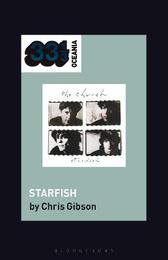
|
The Church's Starfish
Paperback / softback
Main Details
| Title |
The Church's Starfish
|
| Authors and Contributors |
By (author) Chris Gibson
|
| Series | 33 1/3 Oceania |
|---|
| Physical Properties |
| Format:Paperback / softback | | Pages:160 | | Dimensions(mm): Height 197,Width 127 |
|
| Category/Genre | Rock and Pop
World
Bands, groups and musicians |
|---|
| ISBN/Barcode |
9781501387005
|
| Classifications | Dewey:782.421660922 |
|---|
| Audience | | General | | Professional & Vocational | |
|---|
|
Publishing Details |
| Publisher |
Bloomsbury Publishing Plc
|
| Imprint |
Bloomsbury Academic USA
|
| Publication Date |
14 July 2022 |
| Publication Country |
United States
|
Description
After a string of commercial disappointments, in 1986 Australian rock band The Church were simultaneously dropped by Warner Brothers in the US and EMI in Australasia. The future looked bleak. Seemingly from nowhere, their next record, Starfish, became an unlikely global hit. Its alluring and pensive lead single, 'Under the Milky Way', stood in stark contrast to the synth pop and hair metal dominating the 1980s. A high watermark of intelligent rock, Starfish musically anticipated alternative revolutions to come. Yet in making Starfish, The Church struggled with their internal contradictions. Seeking both commercial and artistic success, they were seduced by fame and drugs but cynical towards the music industry. Domiciled in Australia but with a European literary worldview, they relocated to Los Angeles to record under strained circumstances in the heart of the West Coast hit machine. This book traces the story of Starfish, its background, composition, production and reception. To the task, Gibson brings an unusual perspective as both a musician and a geographer. Drawing upon four decades of media coverage as well as fresh interviews between the author and band members, this book delves into the mysteries of this mercurial classic, tracing both its slippery cultural geography and its sumptuous songcraft. Situating Starfish in time and space, Gibson transports the reader to a key album and moment in popular music history when the structure and politics of the record industry was set to forever change.
Author Biography
Chris Gibson is a Sydney-based musician and writer, and Professor of Geography at the University of Wollongong, Australia. His books include Sound Tracks: Popular Music, Identity and Place (2003), Music Festivals and Regional Development in Australia (2012), Outback Elvis (2017) and The Guitar: Tracing the Grain Back to the Tree (2021).
ReviewsIt is the best well-written account and perfectly expresses the character of the band members as well. I can thoroughly recommend it. * Peter Koppes, guitarist for The Church * In his contribution to the 33 1/3 Oceania series, Chris Gibson provides an engaging, insightful look at Starfish, the album that dragged The Church into the surreal world of late-1980s Los Angeles and left them both better-known internationally and forever altered (for better or worse) by the experience. Inviting Gibson, a cultural geographer, to author the book was a stroke of genius. His geographer's eye and musician's ear enable him to capture what is so distinctive about a band that combines the construction of sonic cathedrals and the enigmatic exploration of inner space. Even for fans who have spun Starfish thousands of times, Gibson's narrative opens up new ways of hearing and understanding both the album and the powerful convergence of personal, cultural, geographic, and musical circumstances that produced it. His chapter on the album's ominous opener, "Destination," is especially noteworthy, weaving together pieces of the band's artistic own journey with sharp observations about the construction of a song that remains as stubbornly impenetrable as it is enticing. Drawing on focused, revealing interviews with the band members, later chapters provide memorable stories about legendary Church tracks such as "Under the Milky Way", "Reptile", and "Hotel Womb". Along the way, Gibson also paints a sharp and sensitive picture of the big-city, big-label environment and the punishing studio regimen that yielded one of the most timeless records of the 1980s. * John Collins, Professor and Chair of Global Studies, St. Lawrence University, USA *
|